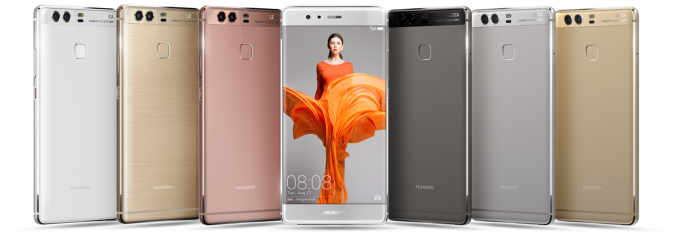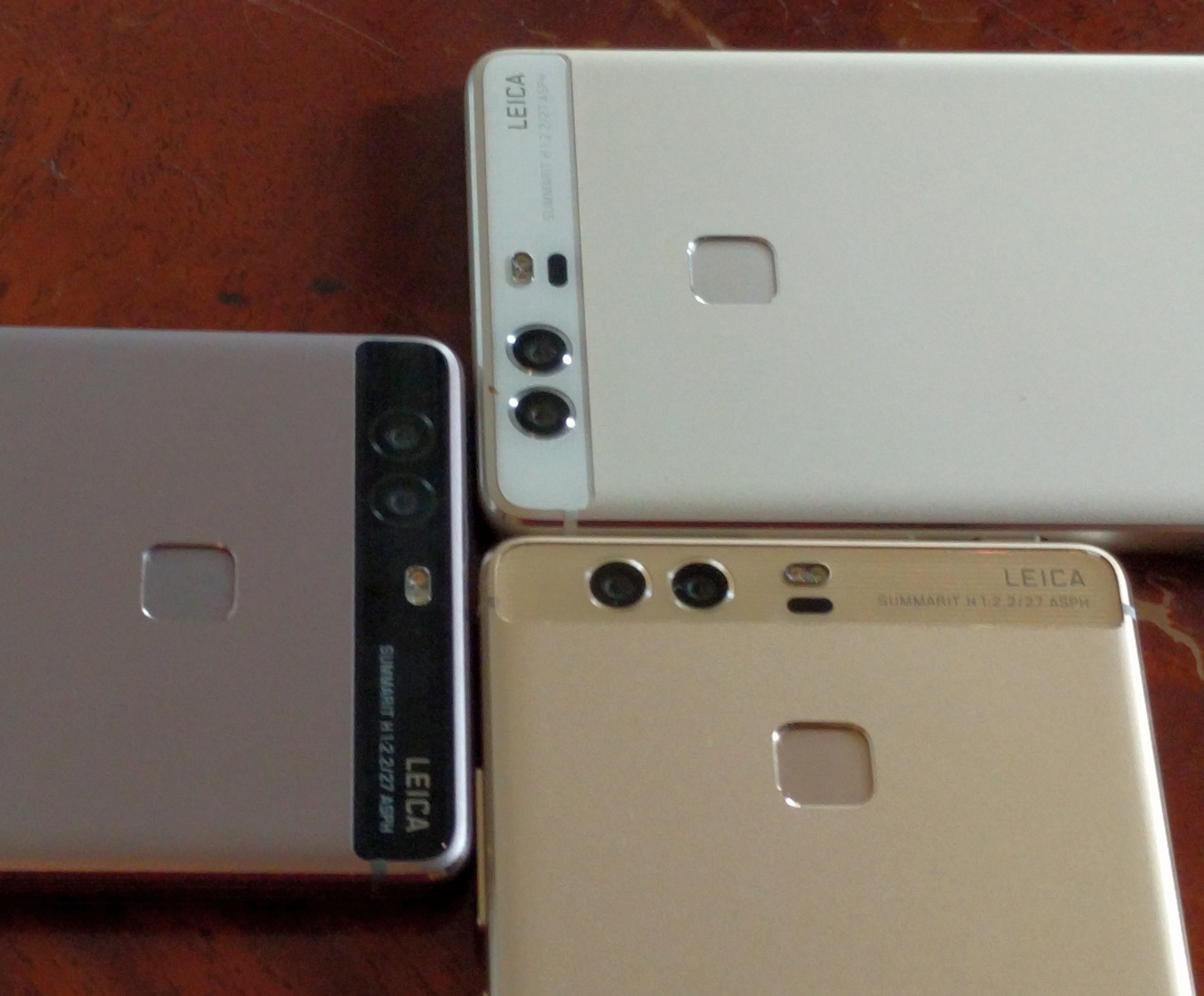Huawei Launches The P9 and P9 Plus
by Ian Cutress & Andrei Frumusanu on April 6, 2016 9:30 AM EST- Posted in
- Smartphones
- Huawei
- Mobile
- P9
- P9 Plus

Today in London, Huawei has launched the latest devices in its P-series line. The P9 and P9 Plus take cues from the previous P8 but also some hardware moves over from the Mate 8 in the form of the SoC base design. The two models come in various memory and storage variants to the EU and Asia, though some colors and high-end storage configurations will be Asia only.
The new P9 and P9 Plus are aluminium unibody designs, with the two main features being the new Kirin 955 SoC and the Dual Camera design on the rear with Leica certification. The way Huawei is using the dual camera design is different to previous dual camera smartphones from other companies – one is a color camera and the other is a black and white camera. This allows several advances over a standard one camera design.
| Huawei P9 & P9 Plus | |||
| Model | P9 | P9 Plus | |
| SoC | HiSilicon Kirin 955 4x Cortex A53 @ 1.8GHz 4x Cortex A72 @ 2.5GHz Mali-T880MP4 @ 900MHz (?) |
||
| RAM | 3 LPDDR3 @ ? MHz / 4GB LPDDR4 @ 1333MHz | ||
| NAND |
32GB / 64GB / 128GB (later) NAND + microSD |
||
| Display | 5.2” 1080p IPS LCD | 5.5” 1080p AMOLED | |
| Modem | 2G/3G/4G LTE Cat 6 (Integrated HiSilicon Balong Modem) |
||
| Networks | TDD LTE | B38 / B39 / B40 | |
| FDD LTE | B1 / B2 / B3 / B4 / B5 / B6 / B7 / B8 / B12 / B17 / B18 / B19 / B20 / B26 / B28 | ||
| UMTS | 850 / 900 / AWS / 1900 / 2100 ( B19 / B8 / B6 / B5 / B4 / B2 / B1) |
||
| GSM | 850 / 900 / 1800 / 1900 | ||
| Dimensions | 145.0 (H) x 70.9 (W) x 6.95mm (D) 144g weight |
152.3 (H) x 75.3 (W) x 6.98mm (D) 162g weight |
|
| Camera | Dual Rear Camera (RGB + Monochrome) 2x 12MP ( X × Y) w/ 1.25µm pixels F/2.2 aperture, x mm eq. |
||
| Front Facing Camera 8MP ( 3264 × 2448 ) Sony IMX179 1/3.2" w/ 1.4µm pixels F/2.4 aperture, 26mm eq. |
|||
| Battery | 3000mAh | 3400mAh | |
| OS | Android 6.0 with EmotionUI 4.1 |
||
| Connectivity | 802.11a/b/g/n/ac dual-band 2.4 & 5GHz BT 4.2, USB-C, GPS/GNSS, DLNA, NFC |
||
| SIM Size | NanoSIM + NanoSIM (w/o microSD) |
||
| MSRP | 3GB + 32GB Europe: 599€ | ||
| 4GB + 64GB Europe: 649€ | 4GB + 64GB Europe: 749€ | ||
Firstly, having black-and-white data means that the grey contrast of an image can be optimized depending on the shot itself. The B/W camera also has fewer color filters in the lens design, allowing for 2x light into the sensor over the color camera, giving an equivalent light data of 3x a single camera design. Thirdly, with two cameras and a separation, based on the contrast data Huawei can use an ISP to attempt triangulation of distance. This allows the integrated software to implement a simulated focal length of F/0.95 to F/16, giving bokeh type effects. This is not a true bokeh, but in the three minutes I played around with the device it did give a similar effect. Both cameras are 12MP, running 1.25 micron pixels and a base F/2.2 aperture. There is a laser autofocus on the P9, but no OIS.
The cameras are Leica certified. The partnership with Leica was announced earlier in the year, but this means that the sensors and lenses pass Leica’s internal tests for color accuracy and reproduction. At this time we were unable to find out who exactly makes each of the sensors, although when we get the device in house (hopefully after the press event today) we can find out. Leica’s partnership also extends to the software, allowing the new camera features to be used.

Both the P9 and P9 Plus have the same camera arrangement and underlying Kirin 955 SoC. This is an upgrade over the Kirin 950 we saw in the Huawei Mate 8, with increased clock speeds (+200MHz on the A72 cores to reach 2.5GHz) and upgraded ISP/DSPs in silicon. HiSilicon states that power efficiency has seen an improvement over the Kirin 950, which should result in outstanding battery life for the P9.
The difference between the P9 and P9 Plus will be in several areas. Both devices are 1920x1080 (FHD) resolution, with the P9 at 5.2-inch and the P9 Plus at 5.5-inch. The P9 Plus will use a Super AMOLED display, with the P9 being a standard IPS but with 69% DCI-P3 gamut. The DRAM/storage configurations will be different as well. The P9 will be available in 3GB/32GB and 3GB/64GB variants (LPDDR3, eMMC), with a 4GB/128GB variant coming to Asia in the future (LPDDR4). The P9 Plus by contrast will have a base 4GB/64GB model, again with a 128GB model for Asia.
The P9 Plus in all variants will feature Huawei’s Force Touch technology, as seen on the Mate S 128GB version, however we are told that the utility of the feature will have increased beyond picture zoom and weighing fruit. Also, the EU will have the Mystic Silver and Titanium Grey colors only, while Asia also gets the Rose Gold and Haze Gold variants.

Both the P9 and P9 Plus will use USB Type-C, with Asian versions supporting Dual SIM functionality. The P9 battery runs at 3000 mAh compared to the P9 Plus at 3400 mAh, with both devices listed as 1.5-day battery run time. Both devices feature the same fingerprint sensor from the Mate 8, with the P9 Plus having an IR blaster as well. Both devices (in our quick hands on) ran Huawei’s customized EMUI 4.1 interface, which is reminiscent of iOS. Both devices also support knuckle interactions, similar to the Mate S.
Pricing for the 3GB/32GB and 4GB/64GB models of the P9 comes in at 599€ and 649€, while the P9 Plus in its 4GB/64GB variant comes at 749€. The P9 should hit the shelves in April, with the P9 Plus in May. 128GB variants for Asia will be slightly later than the smaller storage implementations.
















34 Comments
View All Comments
halcyon - Thursday, April 7, 2016 - link
ProsFast enough Soc: Check
Enough RAM: check
Enough Flash + SD card slot : check
DUAL-sim: check (dual stand-by)
Good camera: Check
IR-Blaster: Check
Decent battery size: check (althoug non-removable)
Super-fast charging: check
Cons:
Fash speed: uh-oh (eMMC)
Screen specs: hmmm (1080p older Amoled)
Water-proofing: none
Memory card interface: old/tired - non UFS-II (i.e. slow)
Wait for P9 Max, if it improves on screen and other features...
Or Note 6, if you can hold out for a beast...
SydneyBlue120d - Thursday, April 7, 2016 - link
Is unlimited HEVC encoding with HDR at 2160p60 supported? Thanks.benmoran - Monday, April 11, 2016 - link
The cameras they 'co-engineered' with Leica performs really well! Lots of detail and with some added touches to the photos taken with this, users will end up with truly amazing photos.http://www.anandtech.com/
Not a fan of AMOLED and prefer IPS, but have nothing against their choice. At least the P9 has the IPS display though. Odd choice to have AMOLED on the Plus.
abufrejoval - Thursday, April 14, 2016 - link
First impression: That's an extraordinary amount of power in your hand or your pocket, so what are you going to do with it?I keep thinking of these super phones as a PC replacement (long before Microsoft labelled that Continuum), one of my desktops is an N3700 Braswell quad core which probably has very much the same CPU/GPU power and works well enough for most tasks on Windows, Remix Android and Fedora.
The only thing missing is some kind of a docking station, which transfers 4k video (or 2x 2k), Gigabit Ethernet, power and cooling.
That docking station should be as unmechanical as possible, because mechanics wear and break, yet provide enough power and (acoustically unnoticible) cooling (e.g. Peltier element cooling the aluminum phone body) to allow the SoC to run at sustained top speeds during desktop operations.
Of course it should also be cheap and commodity, so you can have one everywhere you operate, office desk, meeeting rooms, home office, living room, coffee shop etc.
And your Android should be desktop enabled pretty much the way Remix demonstrates, perhaps even with a (couple of?) full blown Linux Userlands deployable as containers so Ubuntu fans can run Ubunto and Fedora guys their stuff in desktop mode (or even mobile mode, once "desktop Linux" manages to get that right).
All of that implies an unlocked and rooted device of course: Can't have a chinese ultramobile PC manufacturer play admin on my personal computer.
My impression is, smart phones have nowhere to evolve, ultramobile PCs in a smartphone form factor offer plenty of growth opportunities while they pose only organizational, not technical challenges.
I'm looking for a reason to replace my Amoled Note 3 which offers much of that with an MHL/USB docking station that has an HDMI monitor, USB keyboard/mouse and a USB Ethernet adapter connected to it. That runs full blown Softmaker Office or Citrix/RDP clients if a 2.2 GHz Quad Core and 3GB RAM isn't good enough.